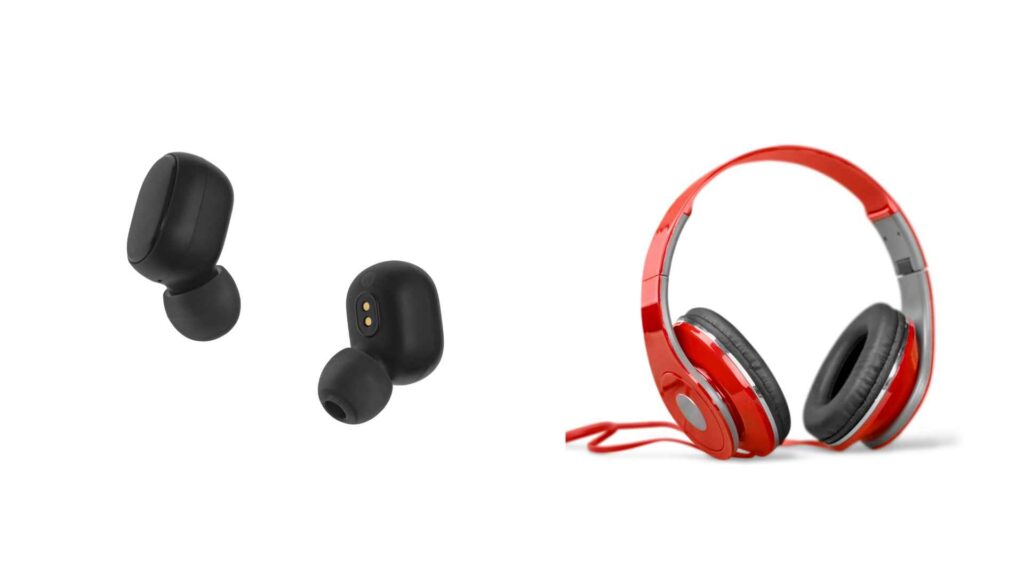In-Ear vs Over-Ear: Selecting the right headphones for exercising is important as the pair of headphones you select can boost your exercise session. Starting from the headphone types such as in-ear and over-ear, every type has something unique about it, and it’s crucial to determine it. This blog post gives you an insight about in-ear headphones and over-ear headphones, and will be useful in deciding which one can suit your workout sessions best.
In-Ear vs Over-Ear Introduction:
As for headphones for workouts, two types of headphones can be distinguished: in-ear and over-ear headphones. This means both types have their pros and cons in terms of comfort, noise, and the workout as a whole. However, through the analysis of these aspects, it would be possible to identify whether one of the styles can be preferable to the other when it comes to exercising, especially when considering options like Wireless Neckband Earphones Under 2000.
In-Ear Headphones: Small Size, Big Impact
Benefits of In-Ear Headphones
- Portability: Manufacturers of in-ear earphones also develop them in small sizes and weight since they are usually portable. Due to their compact design, they can easily be carried around, in pockets, gym bags or small pouches for convenience.
- Noise Isolation: In-Ear earphones models fit in the ears and thus use silicone or foam tips that help in sealing the ear canal. This design assists in the process of minimizing extraneous noise interferences, hence enabling the user to concentrate more on the music and exercise.
- Stability: In essence, in-ear earphones are more fit to the ears thus the likelihood of them falling off during some vigorous activities is very slim. This stability is generally favorable for HIIT, running, or any vigorous movement as it offers stability to support thus providing ideal shock absorption.
Drawbacks of In-Ear Headphones
- Sound Quality: Despite there being many in-ear headphones, they lack the audio output capability as exhibited by the over-ear headphones. Some in-ear earphones have a smaller driver which implies that there could be less reach and intensity of bass.
- Comfort: However, some users complained that using in-ear headphones for a long time is somewhat uncomfortable. The fit into the ear canal is rather snug which can lead to discomfort or even pain when using the headphones for a long time, especially if the tips are of wrong size or made of wrong material.
- Durability: Over-ear headphones normally come as rugged than in-ear earphones due to their design. Some of the cables and small component parts are quite thin and may easily get damaged if not well handled..
Over-Ear Headphones: The Ultimate Sound Experience
Benefits of Over-Ear Headphones
- Sound Quality: These headphones offer some of the best sounds that are within one’s ears due to the nature of the placement of the earphones. They normally use drivers that are bigger and are capable of handling more sound frequencies than smaller drivers hence producing better quality sound.
- Comfort: Comfort is also better given that over ear headphones have cushioned ear cups that rest on the ears. The pressure is applied around the ears and not directly on them; thus, the discomfort is minimized.
- Noise Isolation: Over-ear headphones are better suited to passive isolation primarily because of the large cups that surround the whole ear. Some models also use active noise cancellation – technology, which makes the sound even purer by eliminating the noise coming from the outside.
Drawbacks of Over-Ear Headphones
- Portability: Compared to the in-ear headphones, over-ear headphones are bigger and hence are slightly less portable. It could be large and not foldable; thus, it is not easy to transport from one place to another, especially in small bags or pockets.
- Heat Buildup: Over-Ear Headphones; they cover the ears and when used for long periods especially during exercises they trap heat around the ears. This can lead to discomfort and sweating, which may be distracting during exercise.
- Stability: In particular, it is necessary to note that over-ear headphones are less convenient than in-ear when performing intense physical activities. They can change or completely slide off during exciting moves, and thus are not very suitable for activities such as running or jumping.
Using Headphones for Workouts: Key Considerations
Sound Quality
If one is to choose headphones for workout sessions specifically, Music with good quality sound can motivate you during exercises. Choose headphones with an even frequency response, effective noise isolation, and suitable drivers for the best audio quality.
Comfort and Fit
On the topic of styles that can be recommended for their wearing when listening to music through headphones, it is necessary to emphasize the importance of comfort during long listening. For in-ear earphones, ensure they create a tight seal on the ear tips without pressing uncomfortably on the ear canal. Portable headphones should have comfortable cushions in the ear cups and an adjustable headband to fit the head.
Durability and Waterproofing
Workout headphones should be durable enough to withstand regular use and exposure to sweat. Look for models with robust build quality and waterproof or sweat-resistant features. An IPX rating can indicate the level of water resistance, with higher numbers offering better protection.
Stability and Secure Fit
For intense workouts, stability is crucial. In-ear headphones with secure-fitting ear tips or ear hooks can stay in place during vigorous activities. Over-ear headphones should have a snug fit and an adjustable headband to minimize movement during exercise.
Pros and Cons Summary
In-Ear Headphones
Pros:
- Highly portable and lightweight
- Excellent noise isolation
- Stable fit for high-intensity activities
Cons:
- May lack superior sound quality
- Can be uncomfortable for extended use
- Generally less durable
Over-Ear Headphones
Pros:
- Superior sound quality
- Comfortable for long listening sessions
- Better noise isolation
Cons:
- Bulkier and less portable
- Can cause heat buildup
- May be less stable during vigorous activities
Conclusion
All in all, I have come to the understanding that specialization in the choice of in-ear or over-ear headphones for workouts depends on the individual choice of users, especially when exploring options like the Best Bluetooth Earphones Under ₹3000. Since in-ear earphones do not require any extra equipment and have stable connections and apt frequencies for noise isolation; they are perfect for those who need their headphones to be light and portable and for those who engage in high intensity activities.In their turn, over-ear headphones will be beneficial to users more concerned with sound quality,comfort and isolation.
It can help in making the best decision that reflects on factors like audio quality, comfort, sustainability, and firmness that boost the workouts. Depending on how often and for what purpose you use them, you can find the perfect headphone set for every type of workout regimen, whether it’s an in-ear or over-ear set.






